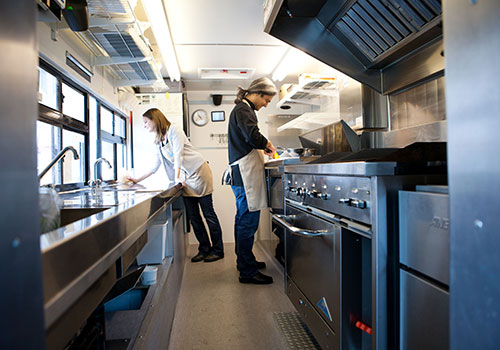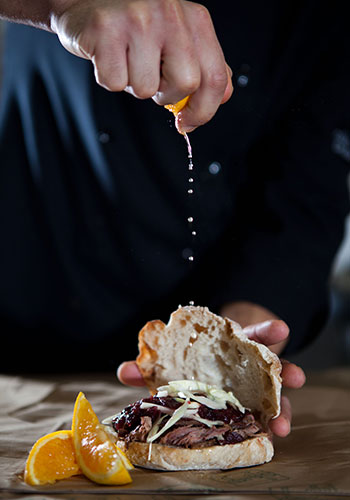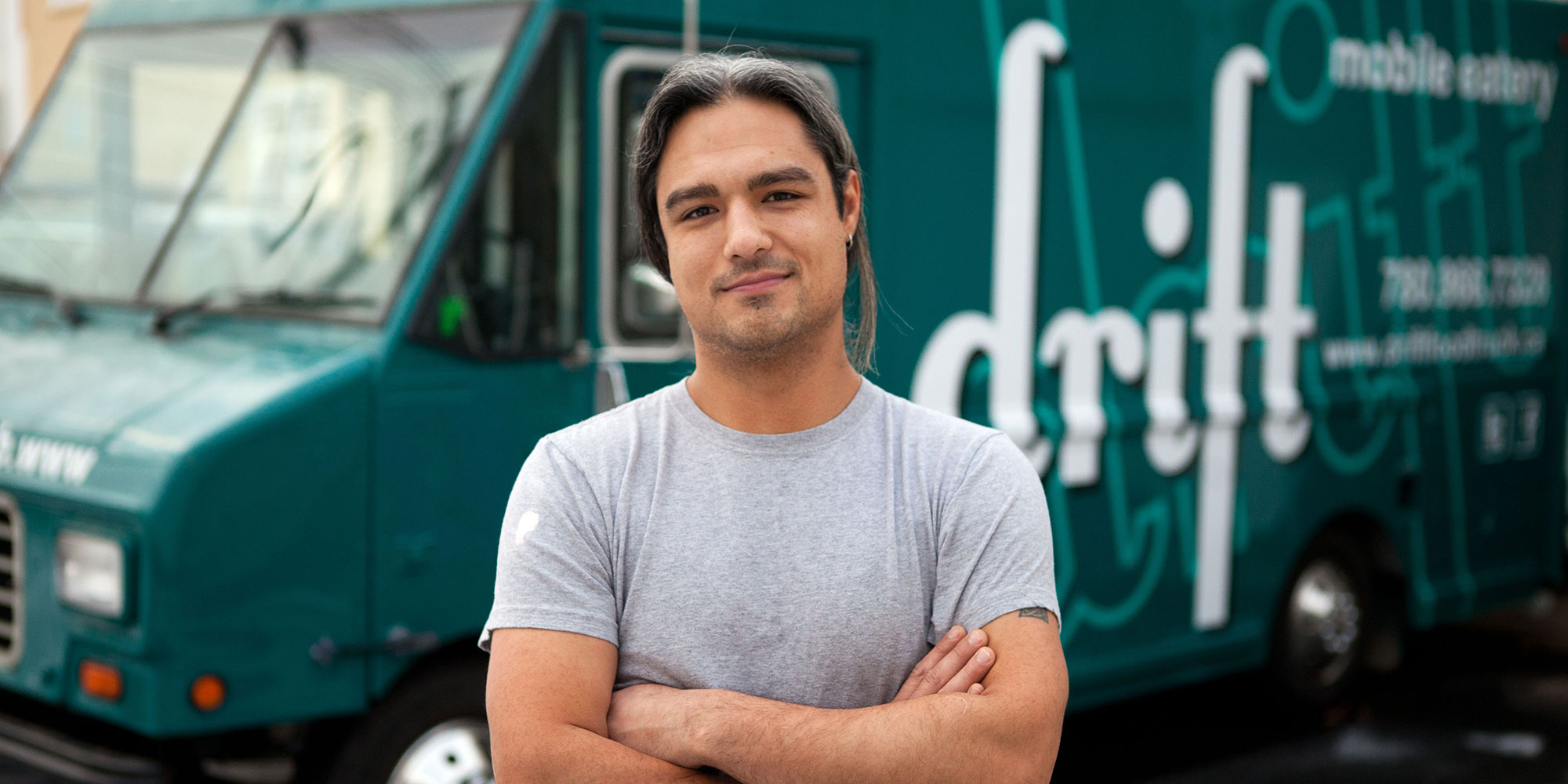Nevin and Kara Fenske take Alberta street food to the next level
There are few notable places to eat lunch on 108 Street south of Jasper Avenue. Forget your lunch at home and your options are donairs, pub grub or fast food. It’s a surprising situation: the surrounding office towers are staffed by thousands, trainloads of commuters spill out of nearby Corona LRT Station and the area’s population of condo dwellers is steadily growing.
Yet few restaurateurs seem willing to chance this pocket of downtown Edmonton.
Nevin Fenske (Cook ’05), in contrast, sees opportunity. A year ago he brought a bit of excitement to 108 Street with his Drift food truck, specializing in gourmet sandwiches.
Painted teal blue, the converted courier truck adds welcome colour to the strip’s concrete and glass façades.
Four days a week, office workers, diehard foodies and curious passersby queue up at his window for lunch. They pore over old postcards doubling as menus and ponder their options. Craving Asian fusion? Go with the pork belly crowned with pickled daikon, cilantro and creamy chili mayo. For something less adventurous, try the back bacon with brie and roasted apples.
The new generation of mobile restaurants is taking street eats to the next level.
In the past year, mobile eateries like Drift have become an increasingly common sight on Edmonton streets. Movable kitchens serving food from all corners of the world are attracting droves. True, food trucks and carts have always served up fries and hot dogs, but the new generation of mobile restaurants is taking street eats to the next level.
The appeal to customers is the novelty of the experience, affordable prices and, in most cases, food quality that rivals that of conventional restaurants. For budding restaurateurs, there’s no need for deep pockets to get started. It’s an appealing concept with the potential to reinvent fast, casual dining – and even bring some much-needed vitality to Edmonton’s downtown core.
 Getting into the food truck scene
Getting into the food truck scene
Back when they were first considering the restaurant business, Fenske and his wife, Kara, started crunching the numbers and found they couldn’t ignore the facts.
A mobile restaurant has lower overhead and fewer staff, which means greater profit margins than a bricks-and-mortar restaurant.
“A couple years down the road, you can already start seeing that money come back after paying off things,” says Fenske, who earned his culinary stripes in the kitchens of Koutouki Taverna, Normands, Glenora Bistro and the shuttered Skinny Legs and Cowgirls.
Even the licensing process is relatively simple and affordable in Edmonton.
To operate a food truck here requires a street vending permit, a travelling or temporary food sales licence and a monthly parking permit from the city. The vendor also has to pass an Alberta Health Services inspection.
But when the deal to secure space fell through, they investigated other options, which included a tour of Portland, Oregon’s “food pods” – lots transformed into outdoor food courts. Impressed with the innovative food, the vibe and the mass acceptance, Fenske needed no further convincing.
By summer 2011, Drift was operating four days a week on 108 Street and once a week at Churchill Square.
He’s not the only one. From his downtown office, Jim Taylor can look across 102 Street at lunch time to see the lineup at Nomad, another popular food truck.
There aren’t many places nearby where you can buy smoked tomato chowder with grilled cheese croutons and pork cheek bacon for under $10.
“I don’t think the average Edmontonian has any idea of the quality that’s being served from these food trucks,” says the executive director of the Downtown Business Association. “It’s not just about convenience food.”
“It’s not just about convenience food.”
Last September, a downtown park and street played host to What the Truck, a food festival solely for food trucks. Several hundred people packed the usually empty space to sample food from 10 vendors. From a revitalization perspective, Taylor is hopeful for more of these kinds of events.
“Vibrant downtowns have interesting street-level activities that draw people out, instead of sitting in an office at noon,” says Taylor. More food trucks might help.
And more might be en route. While Chris Delaney (Culinary Arts ’94) waits for construction to finish on his Big City Sandwich food truck, he’s honing his skills at another culinary phenomenon in Edmonton, the pop-up restaurant, where a visiting chef temporarily takes over an establishment’s kitchen.
If all goes well, Big City Sandwich will be parked weekdays in high-traffic locations around the city and surrounding area by mid-summer.
“You can’t ignore the profitability and versatility of food trucks,” says Delaney, who eventually hopes to pack in his day job selling industrial supplies.
“If a location doesn’t work out, so what? I’m not stuck like a bricks-and-mortar restaurant would be. I can move.”
 A love for food trucks
A love for food trucks
Edmonton may favour chain restaurants – Earls and Boston Pizza opened their first restaurants here – but it’s fairly receptive to food trucks, compared to other Canadian cities.
While Calgary has also been supportive (launching a pilot program late last summer), Toronto has so many restrictions on motorized trucks (it is illegal to park near a restaurant, place of worship or on downtown’s busiest streets), vendors are lobbying to cut the red tape.
Montreal hasn’t allowed mobile eateries since the 1960s, when the mayor outlawed them.
However, as places like Portland have shown, by removing the barriers that hinder potential restaurateurs, cities create environments that nurture the next generation of talented young chefs. And, for their efforts, cities can see their drabber streets revitalized and, thanks to lunchtime lineups, repopulated.
That’s one of the things that keep Fenske going. Running a food truck isn’t easy. Drift is parked street-side for about four hours, but he and Kara work much longer days. At 8 a.m., when Drift’s midday customers are heading into work, they’re at the bakery buying bread. After lunch, they drive back to their commissary kitchen/HQ/garage to finish the remaining half of the 16-hour work day.
“A good day is 12 hours. A typical day is prep, more prep, serve and then more prep,” says Fenske. There is always meat to be braised, stock to be made and an endless amount of produce to be chopped. On Saturdays, if he’s not slinging sandwiches at a local festival, he’s at farmers markets sourcing meat and produce from local suppliers.
Fenske doesn’t really mind the long days, but during the winter break he took time to think about what he can do differently this year. For starters, he intends to streamline the production process to shave hours off the long work days.
“In our first year in business, we were learning from trial and error. We’ve got some ideas now,” he says. He’s considering replacing a few regular sandwiches with daily specials – without drastically altering what has turned out to be a concept Edmontonians have eagerly embraced. “We’re not changing the quality of our sandwiches and ingredients. That’s what keeps people coming back for more.”
